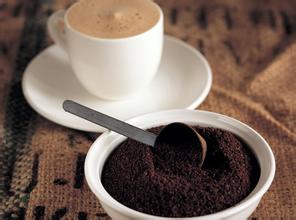What do the types and taste of coffee have in common?
I have to taste it. Mocha coffee has small particles, high acidity, strange and indescribable spicy taste, and a hint of chocolate can be distinguished in the taste. Mocha is the soul of other coffee beans or mixed coffee beans. Angola Coffee, the fourth largest coffee industry in the world, produces only a small amount of Arabica coffee, which is of high quality, but unfortunately, its annual output is extremely unstable due to its political unrest. Ethiopia Coffee Arabica Coffee, the hometown of Arabica Coffee, grows at high latitudes and needs a lot of manual care. There is the famous Esopiamoka, which has a sour taste similar to that of wine, fragrant and productive. Unfortunately, some farmers still do not understand the benefits of picking fruit and allow them to fall behind and pick it up from the ground, but in recent years, due to the continuous expansion of the market, coffee industry is committed to improving harvesting and processing methods, hoping to increase production. Peruvian Coffee, a rising star of Peruvian Coffee, is gradually expanding its popularity and entering the world. It is mostly planted in high altitude areas. Planned planting makes the output large-material-espresso mechanism method: coffee powder 10 g water 50cc sugar-free sparkling beverage (example: Peiluya) ice appropriate amount of lemon juice 10cc general coffee preparation method: coffee powder 30 g water 120cc sugar-free sparkling beverage (example: Peiluya) ice cube appropriate amount of lemon juice 10cc-production method-after the coffee is boiled, pour into a glass filled with ice for about half a cup The characteristic of adding sparkling drinks and lemon juice is that there is no sugar. If you want it to be sweet, you can use syrup or change the sparkling drinks to 7-up. More than 3000 kinds of coffee beans can be produced in more than 50 countries around the world every year. Generally divided into ARABICA? Arabica? And ROBUSTA? Robasta? There are two main categories. ARABICA is of high quality and slightly sour, but has a strong flavor, while ROBUSTA has a strong flavor and is usually mixed with other coffee beans. Some high quality coffee beans such as Columbine beans, Blue Mountain BLUE MOUNTAIN beans, Kenya KENYA beans, Brazil Santos BRAZILIAN SANTOS beans All belong to the ARABICA class, while coffee from Hainan and EKS from Indonesia all belong to the ROBUSTA class. Blue Mountain Coffee from Jamaica, the aroma is very rich, balanced, with a long-lasting fruit flavor. The real Blue Mountain Coffee is one of the best grown coffee in the world. Almost everyone knows that it is the most expensive coffee in the world. The 2100-meter-high Blue Mountains across Jamaica, with cool weather, foggy, frequent rainfall and rich land Rain Water, provide a unique ideal place for coffee growth. High-quality fresh Blue Mountain coffee has a long-lasting flavor and a lingering aftertaste. Colombian Coffee is the largest producer of premium coffee in the world. Traditional deep-roasted coffee has a strong and memorable flavor. Colombian coffee is one of the few original coffee sold in the world under the name of the country, which is the world's largest exporter of Arabica coffee beans. Rich in nutrients, some with nutty flavor. It is often described as having a silky taste. Of all the coffee, it has the best balance, soft and smooth taste, and can be drunk at any time. The most important production area in Colombia is referred to as MAM (the initials of Medellin, Armenia and Manizales), and most of Colombia's top coffee for export comes from MAM. Coffee in Medellin is of the best quality and high price, characterized by full grains, rich nutrition, rich aroma and moderate acidity. Coffee in Indonesia is produced throughout the island of Indonesia, and Java occupies an extremely important position in the history of coffee. The best growing areas are in Java, Sumatra, Sulawesi and Frances. On the whole, Indonesian coffee has a strong taste, mellow taste and good acidity. Java produces exquisite aromatic coffee with relatively low acidity, delicate taste and good balance; Sumatra is heavy, with syrup and chocolate flavor, suitable for drinking after meals. And Sumatra mandheling is known as the world's fullest coffee beans, its unique fragrant taste, slightly acidic taste, quality can be said to be the first in the world. In addition, Arabian coffee produced in Java is the favorite of Europeans, which is sweet in bitterness and sour in the middle of it, which lasts for a long time. Costa Rican coffee the coffee beans produced in the high latitudes of Costa Rica are famous in the world, full-bodied, mild in taste, but extremely sour. The coffee beans here have been carefully processed, which is why they have high quality coffee. The famous coffee is the central plateau? Central Plateau? The soil here consists of successive layers of volcanic ash and dust. Brazilian coffee, the largest coffee producer, accounts for 1/3 of the world's coffee consumption and occupies a place in the global coffee market, although Brazil faces several times more natural disasters than other regions. but its acreage is enough to make up for it. There are many kinds of coffee here, but its industrial policy is large and cheap, so there is not much premium coffee, but it is a good choice for mixing other coffees. One of the most famous is Sandos Coffee, which tastes mellow and neutral. It can be boiled directly or mixed with other kinds of coffee beans to form a mixed coffee. It is also a good choice. Kona Coffee to Hawaii for sightseeing, in addition to the beautiful beach, do not forget the Hawaiian coffee beans-Kona (Kona). The palate is sweet with the acidity of a pleasant wine, very special. It produces Kona on the southwest coast of Hawaii and is the most traditional and famous coffee in Hawaii. However, because the output here is not high, the cost is surprisingly high, and the demand for individual coffee in the United States and other places is increasing, so its unit price is not only getting higher and higher, but also not easy to buy. Yemeni coffee Yemeni mocha coffee was once all the rage, blowing a whirlwind of mocha all over the world. It is slightly alcoholic, spicy, different and must be tasted. Mocha coffee has small particles, high acidity, strange and indescribable spicy taste, and a hint of chocolate can be distinguished in the taste. Mocha is the soul of other coffee beans or mixed coffee beans. Angola Coffee, the fourth largest coffee industry in the world, produces only a small amount of Arabica coffee, which is of high quality, but unfortunately, its annual output is extremely unstable due to its political unrest. Ethiopia Coffee Arabica Coffee, the hometown of Arabica Coffee, grows at high latitudes and needs a lot of manual care. There is the famous Esopiamoka, which has a sour taste similar to that of wine, fragrant and productive. Unfortunately, some farmers still do not understand the benefits of picking fruit and allow them to fall behind and pick it up from the ground, but in recent years, due to the continuous expansion of the market, coffee industry is committed to improving harvesting and processing methods, hoping to increase production. Peruvian Coffee, a rising star of Peruvian Coffee, is gradually expanding its popularity and entering the world. It is mostly planted in high altitude areas, the planned planting greatly increases the yield, the taste is mellow, the acidity is just right, and more and more people like it.

Important Notice :
前街咖啡 FrontStreet Coffee has moved to new addredd:
FrontStreet Coffee Address: 315,Donghua East Road,GuangZhou
Tel:020 38364473
- Prev

Coffee beans produced in the world's major coffee-producing countries
India is the first country in Asia to grow coffee, and India's A-grade coffee beans have always been a coffee that has received strong attention from coffee lovers around the world. Its flavor and taste characteristics: uniform particles, rich taste, smooth and delicious. The cultivation of Indian coffee originated with their colonists, the British. In the 17th and early 18th centuries, the English did not drink tea as much as they do today.
- Next

The origin of Salvadoran coffee. The flavor characteristics of Salvadoran coffee.
In the early 1990s, guerrilla warfare greatly damaged the country's national economy, reducing coffee production from 3.5 million bags in the early 1970s to 2.5 million bags in 1990-1991. The eastern part of the country was most affected by guerrilla warfare, and many farmers and workers were forced to leave the manor. The shortage of funds has led to a sharp drop in coffee production, from 1200 kg per hectare in the past to no yield per hectare today.
Related
- Does Rose Summer choose Blue, Green or Red? Detailed explanation of Rose Summer Coffee plots and Classification in Panamanian Jade Manor
- What is the difference between the origin, producing area, processing plant, cooperative and manor of coffee beans?
- How fine does the espresso powder fit? how to grind the espresso?
- Sca coffee roasting degree color card coffee roasting degree 8 roasting color values what do you mean?
- The practice of lattes: how to make lattes at home
- Introduction to Indonesian Fine Coffee beans-- Java Coffee producing area of Indonesian Arabica Coffee
- How much will the flavor of light and medium roasted rose summer be expressed? What baking level is rose summer suitable for?
- Introduction to the characteristics of washing, sun-drying or wet-planing coffee commonly used in Mantenin, Indonesia
- Price characteristics of Arabica Coffee Bean Starbucks introduction to Manning Coffee Bean Taste producing area Variety Manor
- What is the authentic Yega flavor? What are the flavor characteristics of the really excellent Yejasuffi coffee beans?

